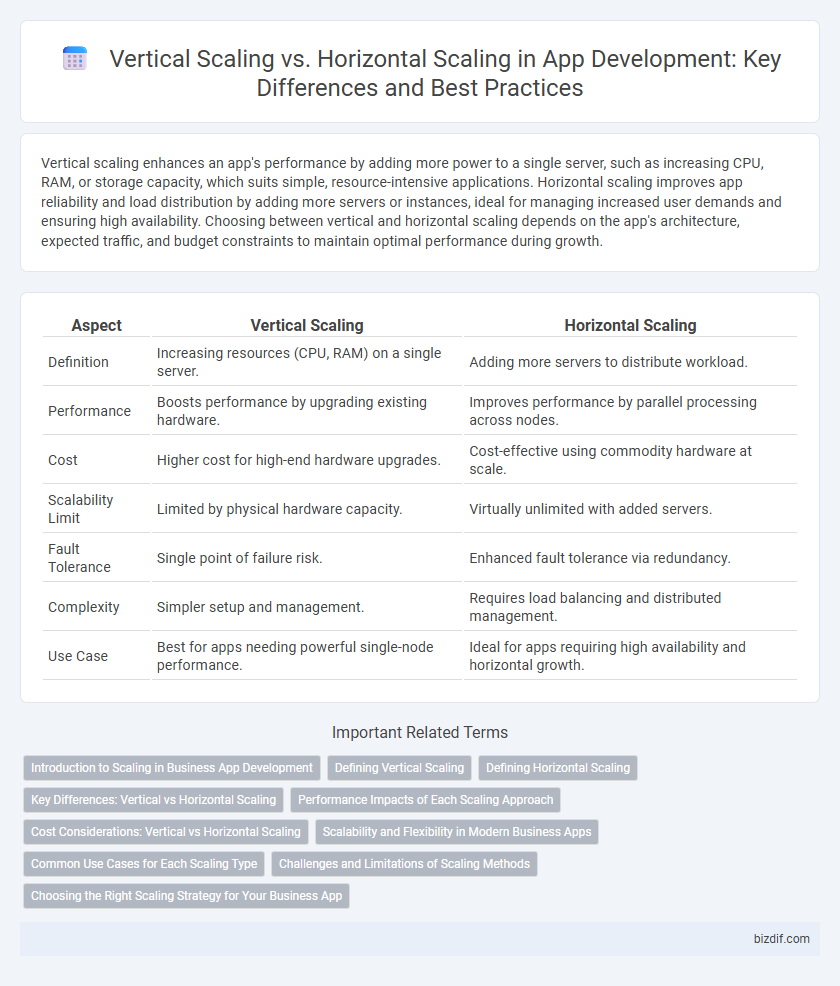Vertical scaling enhances an app's performance by adding more power to a single server, such as increasing CPU, RAM, or storage capacity, which suits simple, resource-intensive applications. Horizontal scaling improves app reliability and load distribution by adding more servers or instances, ideal for managing increased user demands and ensuring high availability. Choosing between vertical and horizontal scaling depends on the app's architecture, expected traffic, and budget constraints to maintain optimal performance during growth.
Table of Comparison
| Aspect | Vertical Scaling | Horizontal Scaling |
|---|---|---|
| Definition | Increasing resources (CPU, RAM) on a single server. | Adding more servers to distribute workload. |
| Performance | Boosts performance by upgrading existing hardware. | Improves performance by parallel processing across nodes. |
| Cost | Higher cost for high-end hardware upgrades. | Cost-effective using commodity hardware at scale. |
| Scalability Limit | Limited by physical hardware capacity. | Virtually unlimited with added servers. |
| Fault Tolerance | Single point of failure risk. | Enhanced fault tolerance via redundancy. |
| Complexity | Simpler setup and management. | Requires load balancing and distributed management. |
| Use Case | Best for apps needing powerful single-node performance. | Ideal for apps requiring high availability and horizontal growth. |
Introduction to Scaling in Business App Development
Vertical scaling enhances business app performance by increasing the capacity of existing servers through adding resources like CPU, RAM, and storage. Horizontal scaling improves application availability and load distribution by adding more servers or instances to the system. Both scaling strategies are essential for handling increased user demand and ensuring seamless app functionality in dynamic business environments.
Defining Vertical Scaling
Vertical scaling in app development involves increasing the capacity of a single server by adding more CPU, RAM, or storage resources to handle higher workloads. This method enhances performance by upgrading existing hardware without altering the application architecture. Vertical scaling is ideal for applications with limited scalability needs or when simplicity of management is a priority.
Defining Horizontal Scaling
Horizontal scaling in app development involves adding multiple servers or instances to distribute workloads and improve performance, enabling systems to handle increased user demand efficiently. Unlike vertical scaling, which enhances a single server's capacity by upgrading hardware, horizontal scaling ensures greater fault tolerance and flexibility by balancing traffic across multiple nodes. This approach supports cloud-native architectures and microservices, promoting seamless app expansion without significant downtime or resource constraints.
Key Differences: Vertical vs Horizontal Scaling
Vertical scaling enhances app performance by upgrading existing server resources such as CPU, RAM, or storage, allowing a single machine to handle increased loads more efficiently. Horizontal scaling distributes the workload across multiple servers or instances, improving fault tolerance and enabling the application to manage high traffic by adding more machines. Key differences include vertical scaling's limitation by hardware capacity and potential downtime during upgrades, whereas horizontal scaling offers better redundancy and flexibility but requires more complex management and load balancing.
Performance Impacts of Each Scaling Approach
Vertical scaling enhances app performance by increasing the capacity of a single server, such as adding more CPU, RAM, or storage, which improves response times and reduces latency for compute-intensive tasks. Horizontal scaling distributes the workload across multiple servers or instances, improving fault tolerance and enabling concurrent processing, which is ideal for handling high traffic and scalable microservices architectures. Performance impacts vary with vertical scaling offering easier management but potential single points of failure, while horizontal scaling delivers greater resilience and flexibility at the cost of increased complexity in design and data consistency.
Cost Considerations: Vertical vs Horizontal Scaling
Vertical scaling typically incurs higher costs due to expensive hardware upgrades and physical limitations on server capacity, which can lead to increased downtime during upgrades. Horizontal scaling offers more cost-effective options by adding multiple low-cost servers, distributing workloads to improve performance with better fault tolerance and flexibility. Cloud platforms often favor horizontal scaling for its scalability and lower incremental cost per additional resource, making it more suitable for growing app development demands.
Scalability and Flexibility in Modern Business Apps
Vertical scaling enhances app performance by upgrading server resources such as CPU and RAM, allowing modern business apps to handle increased loads without altering existing architecture. Horizontal scaling improves flexibility through the addition of multiple servers or instances, enabling distributed workloads and fault tolerance critical for dynamic user demands. Combining both approaches optimizes scalability and resilience, supporting seamless growth and responsiveness in cloud-native and microservices-based applications.
Common Use Cases for Each Scaling Type
Vertical scaling is commonly used in scenarios where increasing the capacity of a single server improves application performance, such as boosting CPU, RAM, or storage for databases and monolithic applications. Horizontal scaling is preferred for distributed systems, microservices, and cloud-native apps where adding more servers enhances fault tolerance and handles increased user loads efficiently. E-commerce platforms and real-time analytics often leverage horizontal scaling, while legacy systems and single-node setups rely on vertical scaling for resource optimization.
Challenges and Limitations of Scaling Methods
Vertical scaling faces hardware limitations, such as maximum CPU, memory capacity, and the high cost of upgrading servers, which can lead to single points of failure. Horizontal scaling encounters challenges with data consistency, load balancing complexity, and increased network latency due to distributed system architecture. Application developers must also address issues like session management and synchronization across multiple instances in horizontally scaled environments.
Choosing the Right Scaling Strategy for Your Business App
Vertical scaling increases a server's capacity by adding more CPU, RAM, or storage to handle higher loads, making it suitable for apps with predictable traffic and limited budgets. Horizontal scaling involves adding more servers or instances to distribute traffic evenly, enhancing fault tolerance and accommodating unpredictable or rapidly growing user bases. Choosing the right scaling strategy requires analyzing app architecture, workload patterns, and budget constraints to optimize performance and cost-efficiency.
Vertical Scaling vs Horizontal Scaling Infographic

 bizdif.com
bizdif.com